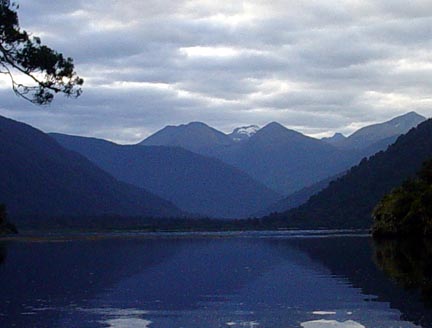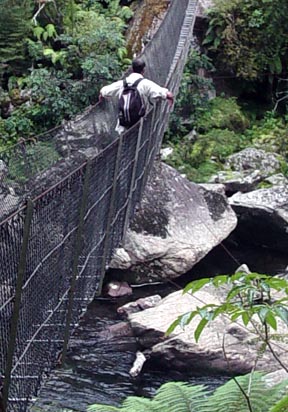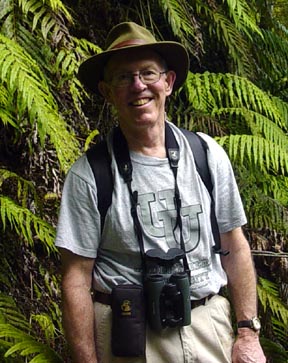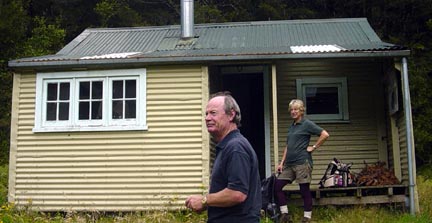March 1 -- At Lake Moeraki
Lake Moeraki is a smallish lake that the Moeraki River passes through
just before it spills into the Tasman Sea. There is no town here, only the
Wilderness Lodge that was created on the site of an old work camp that housed
the road builders that created this part of Rte 6--back in 1965. The
lodge was created as a place that would allow an environmentally friendly haven
for nature-loving guests. It certainly is a great spot, and the program of
nature walks, kayaking, and guided tours is great--the food is also superb.
The morning after my arrival, I took a canoe out on the lake just after
breakfast. It was just a short paddle up river to the lake, and sort of an
idealic picture. The water was clear, and brown trout were jumping
frequently from the water. The fish in this watershed, like that of
most New Zealand fresh waters, is limited. The native fish include only a
few closely related species of Galaxia, which are small catadromous
fishes distantly related to the trouts and salmons. They are only southern
hemisphere in distribution. The juvenile galaxiids are known locally as
"whitebait.". Also native to these waters are two species of catadromous eels (Anguilla
australis, and Anguilla Dieffenbackii).
The life history of whitebait has the adults maturing in freshwater at only
a few centimeters in length. In the fall of the year they run to the
estuaries and spawn at the ocean's edge. The gelatinous mats of fertilized
eggs float off shore, and during the winter hatch into larvae that, in the
spring, make their way back into the river systems and just an inch or two long.
These small fingerlings (the "whitebait") are avidly sought by people who dip them from the water.
They are cooked (often in omelets), and are relished.
The eels (long finned and short finned), have a similar life cycle to our
American Eel. The females spend years in the freshwater rivers, growing to
large size, before undertaking their seaward spawning emigration. As a
show for guests at the Wilderness Lodge, the eels are regularly fed at a feeding station near the lodge,
where dozens of them partake of the daily feast.
The only other fish species in the Moeraki system are the introduced species
of Brown Trout, and the American King, or Chinook Salmon. The trout were
introduced in the 1940s, and have done well throughout New Zealand. They
live in a system without predators or competitors. The sea run salmon
appear in March, but don't reach the size of King Salmon in the Pacific
Northwest.
Paddling into the lake through its outlet, I was greeted with a stunning
view of distant mountains, with snow banks, and a serene lake that had trout
jumping and was dotted with waterfowl.

The cobble bottom supported some rooted vegetation, and was littered with
the shells of an endemic freshwater mussel. The birds included Paradise
Shelducks, Little Shags, Black Shags, Grey Ducks, Black Swans, and New Zealand
Scaup. New Zealand Pigeons and Grey Warblers flew about the shores.
After an hour I was due back at the lodge to go on a guided walk along part
of a track that had been used as a cattle drive trail back in the 1950s, to move
beef cattle from Haast, thirty km south, to the Paringa River, thirty km north
of Lake Moeraki.
Our party consisted of a very knowledgeable guide, Swarde, and two other
guests at the lodge, Christine and Harry White. The White's are Kiwis who
live in the Auckland region and frequently visit this part of the South Island.
They were great companions.
The track ran along the fault line in the Southern Alps that marks the
junction of two plates (Australian and Pacific) that grind against each other, generating subduction and
uplifting along it. You could look down on one side into a deep, heavily
vegetated valley, the rift valley, and up on the other side to the crest of the
alps. It was fascinating. The vegetation was temperate rain forest,
with lots of ferns of many species, tree ferns, rata vine, and massive trees of
silver beech, rimu, and others with long Maori names. Lots of mosses
(including Spanish Moss) and orchids too. Swarde seemed to know them all,
and was a great guide.
The trip reached
the halfway point after crossing a swaying suspension bridge across the roaring
Moeraki River rapids, and reaching a hiker's hut, maintained for campers by the
New Zealand Dept. of Conservation.
.

This is Swarde leading us across the bridge. And me, getting ready
to cross the bridge

And here are Harry and Christine at the Hut.
After eating lunch at the hut, we returned via the same route, seeing much
we missed earlier, and arrived back at the Lodge after a five hour trip, ready
for dinner and rest. Tomorrow it will be off early in the morning for the
drive to Queenstown.




